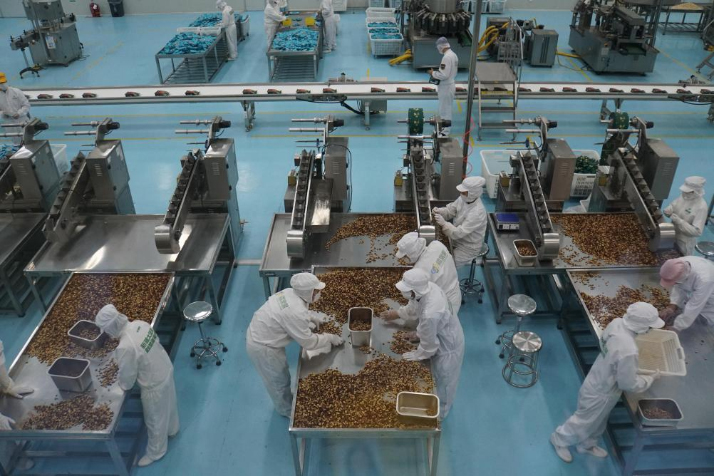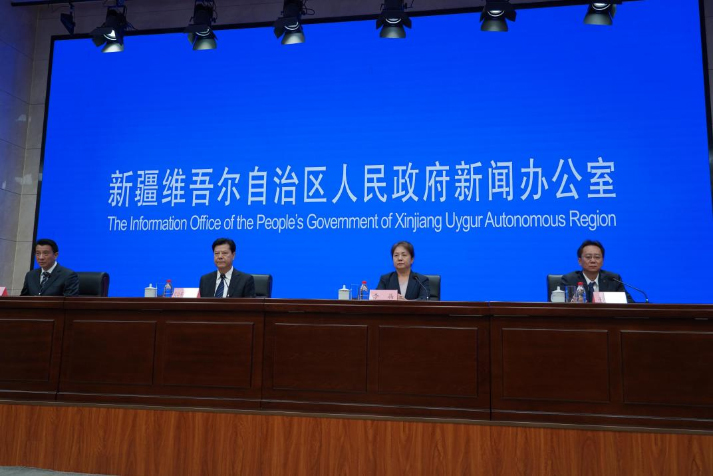| Xinjiang Today |
| All-round improvement in agriculture | |
|
|
 The date processing workshop of an agricultural tech company in Kashi on September 12 (WANG YAJUAN)
Ensuring the stable and secure supply of grain and other major agricultural products is of big importance. Xinjiang has adjusted its food production policy from "self-sufficiency with a slight surplus within the region" to "regional surplus contributing to national supply," demonstrating both a clear commitment and strong capability to serve the national interest. This strategic shift not only reflects the substantial improvement in the region's overall agricultural productivity but also highlights its decisive role in safeguarding China's food security in the new era.
A remarkable achievement In 2024, total output value of the region's agriculture, forestry, animal husbandry and fishery sectors reached 535 billion yuan ($75 billion), up 20.3 percent from 2021, with an average annual growth rate of 6.4 percent. Its grain production has achieved a remarkable leap forward, reaching 23.3 million tons last year, ranking 13th nationwide. Since 2022, the region's grain yields have increased by a cumulative 5.93 million tons over three consecutive years, accounting for 25.1 percent of the national growth. Rising grain production comes from policy support and advances in technology and infrastructure. Authorities at all levels in Xinjiang attach great importance to grain production, with related policies continuously improved—including subsidies for wheat and soybean cultivation and insurance for costs incurred in growing major crops. Initiatives in seed industry development have positioned Xinjiang as a leader in wheat seed production and the country's second largest region in corn seed output. In terms of infrastructure, 3.9 million hectares of high-standard farmland has been built, accounting for nearly 60 percent of the region's total arable land. High-standard farmland refers to arable land with centralized contiguity, supporting facilities, high and stable yields, good ecology and strong disaster resistance. It is adaptable to modern agricultural production and management, ensuring stable and high yields, and is designated as permanent basic farmland. Other sectors have also reached new heights. In 2024, Xinjiang's total cotton output exceeded 5.68 million tons, accounting for 92.2 percent of the national total, providing a solid supply of raw materials for the development of China's textile industry. In the same year, its meat production reached 2.12 million tons, with both beef and mutton output ranking second nationwide; milk production came in at 1.98 million tons; and egg production hit 414,100 tons. In addition, the region's aquatic output amounted to 192,500 tons, the largest among all provincial-level administrative divisions in northwest China.  A press conference on the achievements in the development in the work related to agriculture, rural areas and rural residents in Xinjiang is held in Urumqi on September 29 (WANG YAJUAN)
Marching toward modernization In recent years, Xinjiang has gradually built a modern agricultural system with its own characteristics. A series of policies have been implemented to promote the high-quality development of the agricultural processing sector. In 2024, the processing and conversion rate of major agricultural products in the region reached 65 percent, an increase of 8 percentage points compared with 2021. Focusing on the development of industrial clusters in grain and food processing, cotton, textile and apparel, green livestock products, as well as high-quality fruits and vegetables, Xinjiang has cultivated 10 nationally leading specialty industrial clusters, 14 modern agricultural industrial parks, 55 strong agricultural towns and 27 autonomous regional-level modern agricultural industrial parks. The effects of industrial agglomeration are becoming increasingly prominent. The region also encourages agricultural development by launching the Taste Xinjiang program in 2023, with the aim of selecting high-quality products and establishing a cohesive brand image for Xinjiang agriculture. Brands like Qitai Flour, Jinghe Goji Berry, Korla Fragrant Pear, Aksu Ice Sugar Heart Apple and Ruoqiang Red Date have been included in the national premium agricultural brand cultivation program. Ninety-one geographical indication (GI) agricultural products in Xinjiang have been recognized. A GI is a label that ties a product to its place of origin, where unique natural conditions, traditions or craftsmanship give it qualities that cannot be replicated elsewhere. Marketing channels have been systematically expanded. Trade fairs for Xinjiang's agricultural products have been held in Beijing, Shanghai, Hong Kong Special Administrative Region (SAR) and other places, while efforts are actively made to develop markets in neighboring countries as well as Hong Kong and Macao SARs. Boosting income growth Xinjiang eliminated absolute poverty in late 2020. Through multiple measures, the region has achieved noteworthy results in both increasing farmers' income and consolidating and expanding the achievements of poverty alleviation efforts. In 2024, the per-capita disposable income of rural residents across Xinjiang reached 19,427 yuan ($2,725), an increase of 24.7 percent over 2021, with an average annual growth rate of 7.6 percent, exceeding the national average. Development in formerly impoverished areas has accelerated. In 2024, the per-capita disposable income of rural residents in former poverty-stricken counties reached 18,291 yuan ($2,565), up 3,814 yuan ($534) from 2021, with an average annual increase of over 1,200 yuan ($168), maintaining a growth rate above both the national and regional averages for several consecutive years. This achievement is attributed to a strategy combining industrial development and employment creation. By developing specialty industries, encouraging non-farming opportunities and implementing income-boosting policies, Xinjiang has effectively expanded the channels through which farmers can increase their earnings. Each former poverty-stricken county has developed two to three leading specialty industries, cultivating a group of rural industries with strong driving momentum and promising development prospects. Since 2024, over 6 billion yuan ($840 million) in household-targeted industrial funds have been allocated, providing precise rewards and subsidies across 20 income-boosting initiatives in six major areas: planting, animal husbandry, forestry and fruit cultivation, fisheries, courtyard economy, plus employment and entrepreneurship. Over 1.2 million households have benefited from these initiatives. Efforts to support employment have been continuously strengthened. The employment-focused extreme-poverty-relapse prevention campaign has been implemented, with measures such as expanded work-for-relief programs, effectively promoting stable employment among the working-age people lifted out of absolute poverty. For regions lifted out of poverty, a five-year transition period will apply from the date poverty in their locality was eradicated, during which major assistance policies will remain unchanged for them, according to the poverty alleviation roadmap unveiled by the central authorities. In Xinjiang, the transition period spans from 2020 to 2025, during which 86.87 billion yuan ($12.18 billion) has been allocated for related programs. Support has been coordinated from 19 aid-providing provinces and cities providing pairing-up assistance to Xinjiang , 17 central government agencies, 234 institutions in Xinjiang and 5,764 private enterprises, forming a strong collective effort to consolidate and expand the achievements of poverty alleviation. Improving people's livelihoods Rural infrastructure has reached new levels. For example, 100 percent of rural households live in safe housing. During the January 2024 7.1-magnitude earthquake in Wushi County, Aksu Prefecture, none of the seismic-resistant houses collapsed. Access to safe drinking water has been fully secured, with rural tap water coverage reaching 99 percent. Power grid reliability stands at 99.9 percent. The construction of information infrastructure has accelerated, with 5G network coverage in administrative villages reaching 92 percent and express delivery services available in over 96 percent of administrative villages, further narrowing the urban-rural gap and creating favorable conditions for the development of new business formats such as rural e-commerce and smart agriculture. Xinjiang has been continuously improving its rural living and ecological environments. In 2024, the penetration rate of rural sanitary toilets was 63 percent, the treatment rate of domestic wastewater in rural areas stood at 33 percent and the rural household garbage disposal rate in rural areas reached 90 percent. The largest desert in China, the Taklimakan Desert, has been encircled by a green belt stretching 3,046 km, thanks to more than four decades of efforts as part of China's Three-North Shelterbelt Forest Program, the world's largest afforestation program to tackle desertification. Rural education, healthcare services, senior care and social security have steadily advanced. The completion rate of compulsory education has exceeded 99 percent, laying a solid foundation to break the intergenerational transmission of poverty. Preschool and compulsory education has now achieved balanced access for all. The healthcare safety net is becoming increasingly comprehensive, ensuring that both the formerly impoverished population and monitored individuals are dynamically covered by basic medical insurance, with the "treatment first, payment later" policy effectively implemented. Local patients can now obtain treatment for everyday health issues at the community level, for common illnesses in counties and prefectures, and for serious diseases within the autonomous region. Additionally, standards for rural minimum subsistence allowances and the basic pensions of the basic pension schemes for urban employees, non-working urban residents and rural residents are increased year by year, and low-income populations are fully covered by basic medical insurance on a dynamic basis. Innovative approaches to primary-level governance have been introduced, including the creation of the Uncle Kurban Mediation Room dispute resolution model. Village-level Pomegranate Seed Service Stations have also been established. These are comprehensive community service platforms built across Xinjiang in recent years to enhance grassroots governance and improve residents' quality of life. They primarily focus on senior care, childcare, cultural and recreational activities, and public services, integrating resources to create multifunctional activity spaces. The pomegranate—with its sweet, abundant and tightly clustered seeds—is the central symbol, with each seed representing a life, collectively embodying ethnic unity. Comments to wangyajuan@cicgamericas.com |
|
||||||||||||||||||||||||||||
|